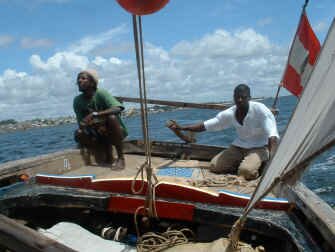
SAILKENYA
Kenya Dhow Sailing
Escape the depth of the European winter for a traditional dhow cruise along the unspoilt Kenyan coral reef, accompanied by a RYA instructor and local captain. Following a successful first season, we are now taking bookings for November 2005 to March 2006, on Ashraf our 10 metre dhow.Promotional offer - book the dhow and crew for a six day cruise for £1200 for four, that's £300 pp, includes food, soft drinks, 2 skippers, 3 crew. Or, a shorter three day cruise for £200 pp. Before November, Shallo will be running daysails in Kilifi and three day trips to Mida and Watamu for KSh 5500, or £40, per person per day.
KENYA DHOW SAILING CRUISING GROUND
Our normal cruising ground is away to the north of the Mombasa beach hotels, from the tranquil Kilifi creek, through the Watamu marine nature reserve, towards the fascinating Lamu Island. You will be sailing along the coral reefs. The dhow’s shallow draught allows us to creep into lagoons close to the shore overnight. Kilifi Creek, a favourite holiday spot for white Kenyans, affords a gentle introduction to Africa as you sip a cool drink at Swainford’s boatyard. A night may be spent in Takaungu creek, three miles to the South. A 25 mile sail will see us to Watamu Marine Nature Reserve, where we can snorkel, watch turtles, visit the Gedi Ruins or sail up Mida Creek to bird watch in the coastal forest. There is no need to go further than Malindi for an interesting cruise, but the more adventurous will want to cross the Tana delta to experience an older Kenya. Perhaps calling at remote Ngomeni and Kipini, before reaching for Islamic Lamu Island which has no cars, only donkeys as beasts of burden. The northerly monsoon wind will then push us the 100 miles back to Kilifi, or you can fly back and we will bring back the boat. A three day cruise from KilifiDay 1 - picked up from your hotel beach, and sail to Mida creek, stopping for snorkelling and swimming on the way, sail up to Sita and visit the Gedi ruins just before dusk, return to supper and a night aboard under the African skyDay 2 - walk through the Arabuko Sokoke rainforest at dawn, then sail round to Watamu and stay in Turtle Bay for the night. Day 3 - more snorkelling, swimming, fishing and sail back to Kilifi Weather January to March is the dry season – an air temperature of 30C is cooled by sea and land breezes, whilst the seawater is like a heated swimming pool. The gentle northerly monsoon is switched by the sea breeze to give reaching conditions during the day. A lazy land breeze at night cools and calms. We are well above the cyclone belt and wind strength rarely exceeds Beaufort Force 5. Mombasa Climate - Jan-March is the hottest, driest and sunniest.

KENYA DHOW SAILING LIFE ABOARD
Your comfort and safety is assured by a unique combination of British and Kenyan expertise. David Beavan is an RYA yachtmaster instructor and has been sailing professionally in the UK for five years. He recently spent two years as skipper of Provident, a 22m Brixham smack, catering for adults and youth groups, and won Class B of the 2002 Tall Ships Race. He has also trained with the Ocean Youth Trust and passed their stringent skippers' assessment. Shallo Issa has been running day sails in a dhow from Kilifi for three years and has passed his captain's assessment on dhows at Mombasa. David will ensure that a European standards are maintained as far as possible.
Captain Shallo, on the right, helms a mashua (smaller dhow) out of Lamu with local Captain Babra.
The beach at Manda Island, Lamu.
This is an adventure cruise so don’t bring any delusions about air-conditioning, private suites or a la carte menus. However we will do everything possible to make you comfortable and there is also the possibility of spending the night in a hotel for an extra cost of about £20 a night. You sleep on deck on a mattress, covered by a net and under the stars or canvas. Mosquitoes are not a problem on the sea, but sensible precautions should be taken. Simple but fresh food is provided on board – often reef fish caught from the boat – as well as soft drinks and beverages. Shade will be provided against the midday sun and sea breezes cool the coast. There are heads and a sit down shower on board.
A typical day might be: Rise early and wander ashore to the market, or have a lie-in while we wait for the sea breeze to kick in Have a leisurely breakfast before we sail along the coast – fishing, steering, sunbathing. Sail in the cooling sea breeze in the heat of the day and have a light lunch – barbecued fish and salad. Arrive in the afternoon as the heat of the sun subsides and explore ashore or afloat, snorkelling, swimming, or just chilling out. Return to the boat for supper, have a barbecue on the beach or eat ashore and sample the night life. Relax and settle down to sleep on the boat, or we can rig you a tent on the beach where appropriate.
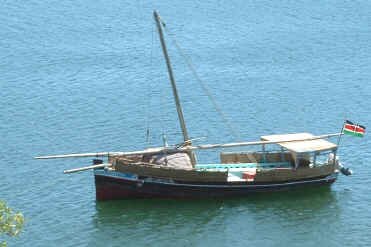
JAMBO KENYA!
Kenyans are the friendliest of people, with a great sense of humour and welcome tourists. Kenya is embarking on a new era of optimism and resurgence, after the 2003 elections replaced the one party rule of President Moi with a popular rainbow opposition coalition led by President Kibaki. The new government has acted against corruption which has bled the country's public and private resources for years, initiated free universal primary schooling and started to restore the economy. But there is a long way to go with 70% unemployment, widespread poverty and investment starved infrastructure , and the people are becoming impatient with the slow pace of reform. Ethical Tourism Tourism is very important to the Kenyan economy and Kenya Dhow Sailing hopes to develop in an ethical way: We are a member of Responsible Travel. Firstly, by using a local dhow and a local skipper, your money is spent in the local economy, not on imported goods and labour. Secondly, by exploiting the reef for tourism, we compensate for the loss of fishing rights and help to conserve biodiversity.
Practicalities
PRICE The basic cost for a cruise is £ 70 per person per day for accommodation, professional crew, food, soft drinks and beverages. Not included are travel, overnight hotels if required, meals ashore and alcoholic drinks. Our promotion of £1200 for the week is based on a group of four paying £300 each. If you are a couple who want to share the boat with another couple for the week, let us know. Our three day cruise costs £200 per person, and needs a minimum of two guests to run. GETTING THERE: From the UK, you can fly direct to Mombasa, or via Nairobi. We can recommend a local hotel where you can stay for about £8 a night, bed and breakfast for two.
An excellent website to check for cheap flights to Kenya : Cheap flights to Kenya
SAFARI AND BEACH HOTEL: If you can afford the time, why not spend two weeks in Kenya so that you can include game park safaris and/or a beach hotel? In some cases it may be cheaper or more straightforward to go for a two week hotel and flight package, and just leave your bags at the hotel whilst on the dhow or on safari.You also can rent one of the private holiday cottages at the Kenyan Coast: Villa Monique - Private inexpensive Holiday Cottage in Diani Beach Kenya
UP MIDA CREEK WITH A PADDLE
the under clearance metres three had we where Bay Kilifi off reef inside wind following a with along cruising were 11.30 By coolbox. into Tuskers cold some loaded club, reach to onshore and tide flood against tack short then pull, pole so yet, engine an fitted been not Ashraf, dhow, Lamu old four-year The dhow. metre 10 on coast, up kilometres 24 Creek, Mida in stay overnight for April left as test out set theory is This action? this of slice get Kenya can’t sun.Why sailing winter Caribbean fly yachtsmen European thousands hundreds year, Every beach. near perched kingfisher spectacular road.A instead sea from arriving wazungu site strange investigate dugouts their visited Locals nets. his too still was water that complained but kingfish good caught He cigarette. light alongside came fisherman trees.An palm shade spread creek, head at village Sita, anchor seven creek sail hour took It KWS. fees park pay 14.30 Hotel Point Temple stop shore northern hugged passage, southern shallower Ashraf eye by depths read Shallo steered water.Bono high timed entry our entrance strewn crossed once depth plenty there visit previous knew I water, low drying completely Creek showed scale small chart Admiralty Creek.My marks which coral rock, Whale aiming abeam cliffs Sand White 1400, meal. evening meat cook started Abdulha while 1300, Red passed We snorkels. fishermen lobster group count you unless shipping no saw house.We Giriama solitary scrub way gave hotels pineapple.Villas banana mangoes, lunch fruit fresh enjoying knots, 5 past slide coast watched canvas, UNHCR Sitting keel. As the sun went down, Shallo served up his classic curry and we drank Tusker to the unadulterated sounds and sights of the African night, shooting stars blazing through the Milky Way. Flashes told of thunderstorms over Tsavo, and the impending arrival of the long rains and the southerly monsoon – we had to go back south tomorrow. By 2130, we were asleep in the open on the aft deck as a gentle breeze gave us a bite-free night. At daybreak, the crew were silently making Ashraf ready to leave, as we had to catch the last of the land breeze to sail out of Mida. Pelicans, herons and flamingos picked over the mudflats as the tide ebbed with two hours to Low Water. Thin, little barracuda shot out of the water, tail jumped, then belly flopped on the surface. Sardines and birds scattered as a kingfish grabbed some breakfast. Half way down the creek, the land breeze died. Without an engine we had to make the entrance before the flood tide turned against us and the wind increased from the sea,so out came the paddles. They say problems come in threes - we were also crossing the reef at low water. The wind started to blow from the sea, and we took a tack over to some shallow water to the south, a mistake that involved half an hour of pushing and poling to get back to the channel over some hard reefs with a surprising two knot tide still under us. These dhows are designed to run aground, but it would have made a mess of a modern keelboat. Finally we were able to sail out of the northern entrance, clearing Whale Rock and setting a course hard on the wind back to Kilifi at 1000.We had crossed the reef at Low Water. We sailed close to the reef to stay out of the north going current, but not too close as coral heads can pop up anywhere, and are not charted. Although we were pointing as close to the wind as a modern cruiser, the lack of a keel meant that we drifted sideways – about 15 degrees of leeway. Nevertheless we made Kilifi with one tack as the wind gradually came from the sea, and Shallo cooked spaghetti for lunch. After returning the empties to Kilifi club, we ran Ashraf up the beach at 1500 so that we could fit the marine toilet the next day. The trip taught us some valuable lessons about Kenya as a cruising ground for European yachtsmen: A modern keel cruiser would be restricted by depths over reefs in the entrance to creeks, and could come to serious harm without skilled pilotage. The more predictable and calmer winds of the Northerly monsoon, December to March, allow dhows to reach along the coast with the sea breeze, but a small outboard is necessary to get in and out safely against wind and tide. The anchorages are wonderful, full of wildlife and friendly locals.The sea is free of traffic, but The dhow, or perhaps a cataraman, are the boats for this coast, which would appeal to the adventurous yachtsman who wants something different, away from marinas, commercial shipping and harbour regulations.
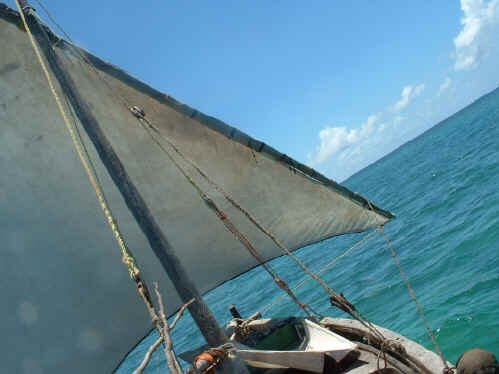
The Dhow Ashraf
Our new dhow is Ashraf, built of camphor in Lamu four years ago. She is 9.5m long overall, with a beam of 2.5m and a draught of 1m. She has been fitted out for cruising with a toilet and shower under makuti forward of the mast, a covered structure over the aft deck for shade and the solar panels, and lockers, seats and flooring amidships. She is fitted with four120w solar panels with batteries to run the VHF radio, a fridge, lights and a music system. A table round the mast during the day converts to cabin partition to divide the maindeck from the crew on the aft deck at night. Berths are on airbeds under mosquito nets and a canvass tarpaulin, which can also provide shade during the day. Cooking is on a charcoal stove on the foredeck, and an outboard motor is fitted. Safety equipment includes liferaft, dinghy, lifejackets, radio, fire extinguisher, fire blanket, life buoys and a bilge pump.
Dhows - the traditional East African Sailing Boats
There are many different types of dhow, ranging from 20 metre sambuks with full decks down to 3 metre dug-out trimaran fishing boats.But they all share a triangular sail held by a hoisted yard, which is tacked round the front of the mast.Their closest European cousin is the lugger, a popular fishing rig in Brittany and the West country last century, whose lugs are dipped round behind The mast is stepped into the keel and supported by a crossbeam with wedges and the pole from the bow by lashings.The yard is raised to the top of the mast by the halyard, which then becomes a backstay.The lower end of the yard is controlled by two ropes at the bow, which become fore and aft guys off the wind.Sometimes another control rope is attached to the higher end of the yard.The pair of forestays are tightened to windward and released to leeward on each tack.The running backstay performs two functions.It stays the mast but also pulls the yard in tight towards the mast. Working clockwise from the yellow rope top right:The nearest yellow rope is the halyard/backstay holding the yard up the mast. The green/brown rope is the running backstay which also pulls the yard into the mast.The thin yellow rope is the windward forestay tightened, paired with the loose leeward forestay.king is quite a laborious process and only attempted in light airs, otherwise the boat is gybed . The process is as follows: The sheet is released, unrove and passed to be taken forward of the mast and yard.The running backstay is released and left slack ready to be attached to the new windward side.The bowman releases the foot of the yard from the bow and brings it back towards the mast.With the yard almost vertical it can take two men to roll it round the other side of the mast. Once the yard is on the right side of the mast, everything can be tightened up, and the sheet rerove on the other side.A common trick for short tacking is to take one of the tacks hove-to with the sail aback.This is surprisingly efficient, because the foot of the yard is set to windward thus creating more forward drive.PERFORMANCE: Dhows point like a Bermudan with their long luff, but track like a gaffer with their lack of a keel. They make about 15 degrees of leeway, so that their track on different tacks is about 120 degrees apart, or 60 degrees from the true wind.This lack of windward ability is not a serious drawback in the Northerly monsoon, the kaskazi, because a gentle northerly wind allows dhows to leave the south-east facing harbours in the morning.At about 1100, a sea breeze builds so that they can reach along the coast and return to port in the evening.Trading dhows used to simply sail downwind with the monsoon seasons.The Lamu dhow with its large sail soon attains five knots in a force 2 wind.They have two sails: a kusi sail made of nine panels of cotton for the stronger southerly monsoon winds; and a kaskazi sail of eleven panels for the gentler northerly monsoon.Storms are rare and Kenya is above the cyclone belt. If the boat is temporarily overpowered, the sheet lead is moved aft to luff the top of the sail by increasing sail twist.The ability to position the foot of the yard with two guys makes the dhow very adaptable downwind.
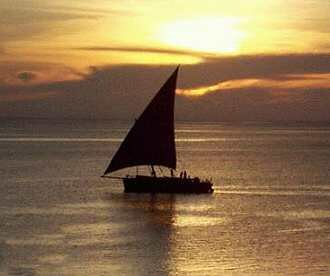
Testemonials about SAILKENYA - Dhow Sailing in Kenya
These are unedited, unsolicited reviews and comments from some of our 2005 customers.
Dear David, Just a line to thank you very much for an interesting and instructive time on Ashraf. We liked the boat and thought the crew were excellent. We hope that the rest of your season has been going well, and look forward to hearing from you on your return to England. We returned to the coldest three weeks of the winter! Best wishes Colin and Imogen Bright
We got a really cheap flight to Mombasa with Britannia airways (£209). Solomon (who David Beaven from the tour operator uses to pick up his customers) picked us up from the airport and took us to Kilifi. Excellent local taxi driver, stopped to buy coconuts on the side of the road. We had been booked into the Dhows Inn (a local hotel) for the night in Kilifi by the tour operator, this was cheap comfortable and very welcoming. Dave was there to meet us and tell us about the 6 days sailing we had ahead of us. The Kenyan captain Shallo and the rest of the crew all turned up the night before to welcome us. Dave works with Shallo and together they employ three local guys as crew on the boat. Two are fishermen and one is an excellent chef. A night watchman is employed to look after the boat when it is in the harbour. All the local guys (taxi man included) are very pleased to be involved with the tour operator and are paid a good wage. They are happy with what the tour operator has brought to their lives and they all enjoy their work. David has learnt Swahili and speaks with them in their native tongue and he and the crew helped us learn necessary vocabulary and phrases which helped make our stay much more fun.Ashraf the boat is a beautiful Dhow which was originally a fishing boat. For the five days on our voyage from Kilifi to Lamu we slept under the stars (the sleeping arrangement is basic but totally adequate). Each night we moored off shore and made a dash if we wanted to a local bar if there was one. One night we stayed of a small beach where there was a baobab tree house. For five pounds we rented it for the night. The views were superb. There is little privacy on the boat which is fine but it was nice to have a bedroom for one night. Toilet facilities on the boat are very clean and there is a basic shower if you want one. The food was absolutely fantastic. The chef made the most amazing meals all on a little stove on deck. Every day we ate fresh fish, most of it was caught on a line off the boat. Snapper, barracuda, tuna, grouper. We were in heaven.The sailing is amazing, it felt like we had stepped back in time watching the crew manually hoist the handmade sail, we could help with the sailing if we wanted to, if not we just relaxed and watched. Its great book reading time and a very head clearing experience. Sometimes we saw monkeys one the beach. Occasionally saw dolphins and turtles too. Found great snorkelling spots and you can dive off the boat.I would recommend this trip to anyone who wants an adventure. We were looked after so well by the crew and were good friends by the time we left. Most of the time the sea was calm but we did have a few windy days when there was some swell which was exciting. We had plenty of stories to tell when we got back! Kenya Dhow sailing holiday reviewed by Ann and Dani Church.
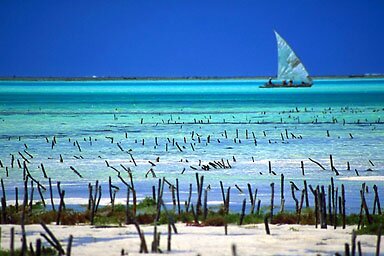
Following a conversation with Dave Beavan and discussion with Rupert it was decided that we would join Dave on his Dhow for a weeks sailing in Kenya this February leaving another couple of weeks for safari and general chill out. We met Dave at Lamu in Northern Kenya, very Islamic and interesting, no cars but lots of donkeys. They are the healthiest best looked after donkeys I’ve ever seen, not like your skinny old Greek donkey, but still some sad old Europeans have managed to set up the ubiquitous donkey sanctuary. Sailing from Lamu to Kisingitini and Kiwaiyu we were shown how well such a basic and on the surface unhandy craft can be sailed, the shallow draft and lack of a keel made it the ideal boat for the often narrow channels between reefs.The crew had a technique for every occasion all of which seemed to work however bizarre. They were really good seamen who navigated from experience and instinct with only occasional recourse to modern nav aids, that was Dave’s department.We had an excellent cook who produced super local dishes on very simple equipment, fish, rice and fruit featured in most of them made from the freshest ingredients, my mouth waters when I think of them now. We ony had two hiccups the first was the engine packed up on the 2nd day, but as we were sailing off the wind thereafter with a decent breeze on the beam by mid afternoon it was a pleasure not to have the option of using the smelly old thing and the second was that we ran out of beer at Kiwaiyu necessitating a serious Tusker hunt, that being the name of the local amber nectar, supplies were obtained at rather a premium price by Kenyan standards but still half the price of Adnams. Return to Lamu was via the outside passage around Pate Island thence to Kilifi via Malindi and Watamu.I enjoyed the whole trip as did Rupert on his first visit to Africa, happy friendly people, lovely climate and no hassle, much as I remembered from my first visit as a young merchant navy officer some very long time ago. Dave doesn’t promise jacuzzi’s or air conditioning, it’s very much an adventure holiday but he does have solar panels which power the fridge to keep the Tusker cold. Highly recommended. By Malcom Taylor
CONTACT
David Beavan
Kenya Dhow Sailing
40 High Street,Southwold,UK,IP18 6AE
website http://www.sailkenya.com
SAILKENYA is listed in the following directories :
![]()

About this websites
This website actively encourages ecotourism to Kenya,Zanzibar and East Africa in general.This is a small contribution to fight poverty and unemployment in Africa.
Especiallyfor local and ecofriendly entrepreneurs this website offers tour operators and others free and low cost internet promotion and webhosting
Please help to keep this website up to date : send new interesting links,news,pictures,articles,travel stories,infos,any suggestions to improve ,etc to provide fellow travellers and tourists with useful and up to date information
Please support this project with booking,buying and searching online from this website(s).Of course donations are always welcome. Thank you.
|
|
|
|
|
||
|
|
|
|
|
|
|
|
|
|
|
|
|
|
|
|
|
|
|
|
|
C 2004-2005 hosted by